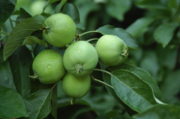Fruit: Thinning Excess Fruit

A few areas of Kansas have avoided late freezes resulting in a heavy fruit crop this year. At first glance, this might seem to be a good thing. But too many fruit can cause problems that should be alleviated by removing excess fruit (thinning). For example, a heavy fruit crop can interfere with fruit bud development this summer. This can result in a small to no crop next year. This problem most often appears with apples. Thus, thinning helps ensure that good crops are produced each year.
The second benefit of thinning is to promote larger fruit on this year’s crop. Fruit trees are limited in how many fruit they can mature. Too many fruit and fruit size and quality goes down.
A third problem often caused by too many fruit is limb damage. Sometimes the weight of a maturing fruit crop can literally break branches. Thinning will help limit weight and preserve branches.
So how much thinning should we do? Thinning recommendations vary with the type of tree.
Guidelines for fruit spacing are as follows:
Apples and pears: 4 to 6 inches apart;
Peaches: 6 to 8 inches apart;
Plums and prunes: 4 to 5 inches apart;
Apricots: 2 to 4 inches between fruit.
These are averages and so you may have several fruit clustered closer than this distance. As long as the average on the branch is close to the recommended spacing, the fruit should size well.
Cherries are not thinned and can produce a full fruit load. (Ward Upham)
The second benefit of thinning is to promote larger fruit on this year’s crop. Fruit trees are limited in how many fruit they can mature. Too many fruit and fruit size and quality goes down.
A third problem often caused by too many fruit is limb damage. Sometimes the weight of a maturing fruit crop can literally break branches. Thinning will help limit weight and preserve branches.
So how much thinning should we do? Thinning recommendations vary with the type of tree.
Guidelines for fruit spacing are as follows:
Apples and pears: 4 to 6 inches apart;
Peaches: 6 to 8 inches apart;
Plums and prunes: 4 to 5 inches apart;
Apricots: 2 to 4 inches between fruit.
These are averages and so you may have several fruit clustered closer than this distance. As long as the average on the branch is close to the recommended spacing, the fruit should size well.
Cherries are not thinned and can produce a full fruit load. (Ward Upham)



Leave a Reply
You must be logged in to post a comment.